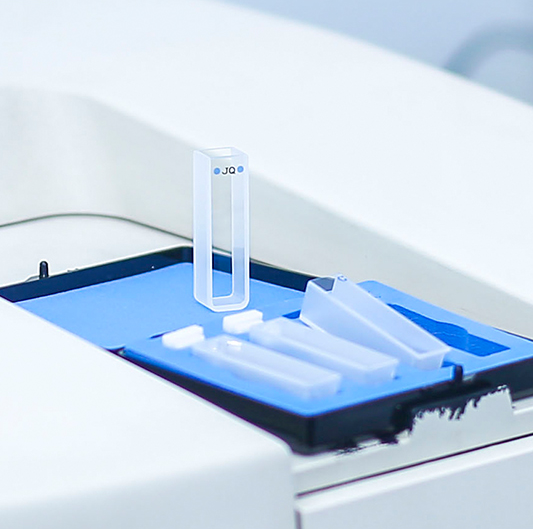Your cart is currently empty!

Quartz Cuvette
A Quartz Cuvette, also known as a quartz cell or quartz sample cell, is an essential component in spectroscopic analysis. Here is a detailed introduction:
Characteristics
Material Properties: Quartz cuvettes are made from high-purity quartz material. Quartz has excellent optical transparency, especially in the ultraviolet (UV) to visible light range, allowing for accurate spectroscopic measurements in these regions. It also has a relatively low coefficient of thermal expansion, which means it can withstand moderate temperature changes without significant deformation, ensuring the stability of the optical path.
Optical Performance: The two parallel sides of a quartz cuvette are highly polished optical surfaces. These surfaces provide smooth and flat interfaces for light transmission, minimizing light scattering and reflection. This results in a high signal-to-noise ratio in spectroscopic measurements, enabling more accurate detection and quantification of analytes. The precise manufacturing process ensures that the optical path length within the cuvette is consistent, which is crucial for obtaining reproducible and reliable results.
Chemical Resistance: Quartz is chemically inert to most substances, making quartz cuvettes resistant to corrosion and chemical reactions. They can be used with a wide variety of solvents, acids, bases, and other chemicals commonly encountered in laboratory analyses without significant degradation or contamination of the sample or the cuvette itself. This chemical stability allows for the analysis of different types of samples in various chemical environments.
Applications
UV-Visible Spectrophotometry: Quartz cuvettes are widely used in UV-visible spectrophotometers to measure the absorption or transmission of light by a sample in the UV and visible spectral regions. This technique is used for quantitative analysis of substances such as organic compounds, inorganic ions, and biological molecules based on their characteristic absorption spectra. For example, in the determination of the concentration of a particular drug in a pharmaceutical formulation, a quartz cuvette is used to hold the sample solution, and the absorbance of the solution at a specific wavelength is measured to calculate the drug concentration.
Fluorescence Spectroscopy: In fluorescence spectroscopy, quartz cuvettes are used to contain the sample being excited by light to emit fluorescence. The excellent optical properties of quartz cuvettes allow for efficient excitation and collection of fluorescence signals, enabling the detection and characterization of fluorescent compounds. This is useful in fields such as biochemistry, where the fluorescence of proteins, nucleic acids, or other biomolecules can be studied to understand their structure and function.
Infrared Spectroscopy: Although quartz has some absorption in the infrared region, specially designed quartz cuvettes can still be used for certain infrared spectroscopic applications, especially in the near-infrared range. Infrared spectroscopy is used to study the vibrational modes of molecules and can provide information about the chemical composition and structure of materials. Quartz cuvettes can be used to hold liquid or solid samples for infrared analysis, depending on the specific requirements of the experiment.
Precautions for Use
Cleaning: After each use, quartz cuvettes should be cleaned thoroughly to remove any residual sample or contaminants. They can be rinsed with distilled water or an appropriate solvent, followed by gentle scrubbing with a soft brush if necessary. Ultrasonic cleaning can also be used, but care should be taken to avoid using excessive power or harsh cleaning agents that could damage the optical surfaces. It is important to ensure that the cuvettes are completely dry before reuse, as moisture can affect the accuracy of spectroscopic measurements.
Handling: When handling quartz cuvettes, it is essential to avoid touching the optical surfaces with bare fingers, as the oils and dirt from the skin can contaminate the surface and affect light transmission. Instead, hold the cuvette by its frosted or textured sides. Additionally, cuvettes should be placed gently into the instrument’s sample compartment to prevent scratching or chipping of the optical surfaces. If a cuvette is dropped or damaged, it should be discarded and replaced, as even minor scratches or cracks can significantly affect the optical performance.
Matching and Calibration: In some spectroscopic techniques, it is necessary to use cuvettes that are matched in terms of optical path length and transmission characteristics. This is particularly important for accurate quantitative analysis. Cuvettes should be calibrated regularly to ensure their accuracy and reproducibility. Calibration can involve measuring the transmission or absorbance of a standard reference material using the cuvette and comparing the results with known values. If the deviation exceeds a certain limit, the cuvette may need to be recalibrated or replaced.
